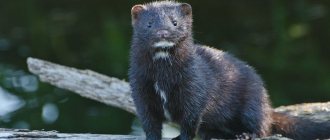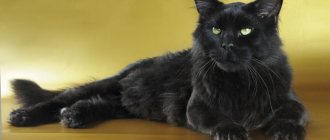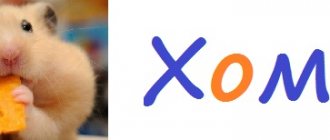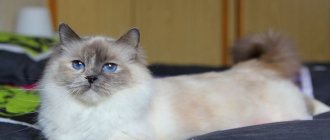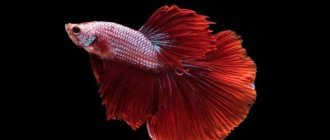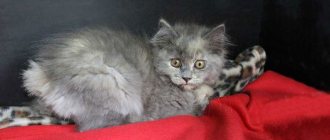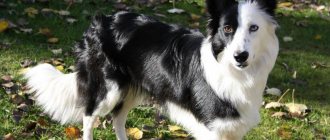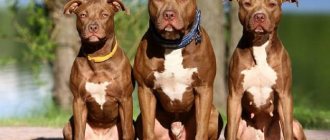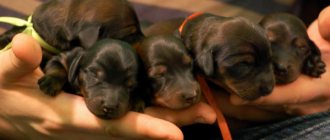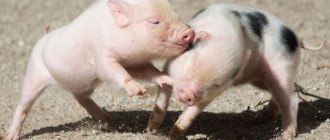It is believed that the mink is difficult to tame and can become aggressive in captivity. This is somewhat wrong. Both European and American varieties of mink adapt perfectly to home keeping and to fur farm conditions. Naturally, when bringing an adult mink into your home, you should not expect the animal to be submissive. If a mink is taken in infancy, then it can become an obedient pet.
Who is Mink?
Mink is a small predator from the mustelid family, which makes them similar to martens, otters, badgers and ferrets. Minks love to settle along the banks of rivers and large bodies of water, since the basis of their diet is fish, frogs and crayfish. However, the animal does not disdain small rodents and birds.
As a home, the animal uses either its own dug holes or those of others. For example, an abandoned burrow of a mole, a water rat, or even a low-lying hollow of a tree growing next to a pond would be suitable for this role.
Today, there are two species to which the name mink is applied—the American mink and the European mink. These are quite close, but still separate species. A species is an evolutionarily established collection of individuals, characterized by a single... animal. They are very similar in appearance, lead a similar lifestyle, but do not interbreed in the wild, and therefore are ecological competitors of each other.
Choosing a pet when purchasing
Prices for animals from the mustelid family can vary greatly. Some sellers offer predatory animals at prices starting from $50, others want $300 or more for their pets. Everything will depend on the type of mink, the quality of its wool, the popularity of the nursery and the living conditions in it. Be that as it may, the only important fact remains that the animal should be purchased only at a young age. If you buy an adult, there is a high probability that you will never be able to find a common language with your pet.
Breeding and selling mink is not as common an activity as, for example, breeding German shepherds or British cats. This is due to the popularity of these pets, which is only gaining momentum and is still at the very bottom of the ranking. The easiest purchasing option is to search for good nurseries on the Internet.
Of course, if there are nurseries in your city where mustelids are bred, this will make your task much easier. Choosing a healthy baby is not so easy, so it is better to take an experienced friend or veterinarian with you to the nursery. The cub must be mobile, active, without visible defects on the skin and musculoskeletal system. His coat and eyes should be shiny and there should be no sign of excrement under his tail.
To protect yourself and your loved ones, read about wild cats that are best not kept at home.
European mink
European minks have an elongated arched body and powerful short limbs. The average body length is 35-40 cm with a weight of just under 1 kg. Including the tail, the length is up to 60 cm. The paws have interdigital membranes, which simplifies hunting in the aquatic environment. The skin is covered with dense fur with a thick undercoat that practically does not get wet. Thanks to this, animals tolerate low temperatures, including cold water. The wool is colored predominantly dark brown. A characteristic feature is also the white muzzle, thanks to which the mink always looks very funny in the photo.
Until the middle of the last century, the European mink was widespread throughout almost all of Europe, with the exception of the north-west and the far south. However, to date, its habitat has narrowed to the Vologda and Arkhangelsk regions of Russia, as well as small isolated enclaves in Spain, Romania and the Baltic states.
The reasons for the disappearance of the animal from most of its historical range remain unclear, since not a single theory in this regard has been properly confirmed. It is believed that urbanization and the spread of the American mink in Europe only spurred the extinction of the “European” mink, but were not the original causes of this process.
American mink
The American mink is very similar in appearance to its European relative, but genetically it is closer to sables and martens. It is believed that “Americans” and “Europeans” arose as a species. A species is an evolutionarily established set of individuals characterized by a single ... independently of each other (that is, they do not descend from a common ancestor), and external similarity is the result of evolution in identical living conditions.
The body length of the “American” reaches 60 cm, and including the tail - 90 cm. The weight of an adult varies between 2-3 kg. The swimming membranes are poorly developed, but the fur cover is much thicker than that of the “Europeans” and is colored black and gray. In addition to size, the key difference between the American mink and the European one is the color of the muzzle: the “American” mink has only the lower lip and chin painted white, while the “European” mink has the entire muzzle white.
The historical habitat of this species is North America. Minks inhabit ¾ of the continent: they are not found only in the extreme northeast of Canada, the southwest of the United States, Mexico and the countries of the Isthmus of Panama. When the boom of industrial fur farming began in the 20th century, American minks were brought to Europe and the USSR for breeding in order to obtain valuable fur. The individuals that found themselves free quickly multiplied and occupied the ecological niche vacated by the extinction of the European mink. Today, American women are found everywhere in northern Europe and northern Asia, as well as in Japan.
The lifestyle and habits of the “American mink” are generally similar to the European mink, but thanks to their more massive body, they can hunt both small and relatively large prey, for example, muskrats and even poultry.
Domestic mink
Until the second half of the 19th century, there were no serious attempts to domesticate minks. Only when fur hunting ceased to satisfy the growing demand for fur did minks, along with other fur-bearing animals, become the object of fur farming. The real boom began in the 20th century in the USSR, which was accompanied by the creation of huge fur farms, where, among other things, American mink began to be bred.
Preference was given to the American mink in fur farming due to the fact that this animal produces higher quality and more beautiful fur. Today, along with Russia, mink breeding is most actively practiced in Scandinavia and Canada. And although fur farms also exist in other European countries, the volumes of fur production there are small. This is due to the fact that the highest quality and most expensive fur comes from animals raised in cold climates. Russian, Canadian and Scandinavian mink are especially valued in the world.
In the second half of the 20th century, minks began to be used as pets. Minks began to appear in apartments and private houses instead of annoying cats and dogs. Despite all the cuteness and funnyness of this animal, it has not gone through the same long path of selection and adaptation to the conditions of coexistence with humans as cats and dogs. Because of this, minks are much less amenable to training, cause a lot of trouble when kept at home, and get along very poorly with other domestic animals.
Minks tend to obey only one owner, ignoring or even being hostile to other family members, not to mention people who come to visit. Even ferrets, which are also not far from the wild state, are much more obedient and friendly pets.
However, this does not mean that minks are completely unsuitable for home keeping. If you take a puppy at as early an age as possible and put every effort into raising it from the very beginning, it may very well turn out to be a good-natured, cheerful and obedient pet mink.
Communication
A mink, making different sounds, shows its emotions - a hoarse hiss most likely indicates fear or some kind of dissatisfaction, and a gentle cooing most likely indicates a mating mood. A sharp whistle is a sign of anger or fear; wild animals make it when they are picked up. It must be remembered that a mink can bite quite painfully; if the animal requires vaccination, it is advisable to handle it only with thick gloves, carefully holding its neck. Vaccinations for animals must be done annually; vaccinated minks can be walked on a leash in the yard or go on vacation with them.
Mink: care and maintenance of a pet
Both European and American mink can be kept as a pet. However, due to the fact that the “European” is a rarer species and is even listed in the Red Book, American minks are still more common.
By and large, caring for and maintaining a mink in an apartment is not much different from keeping a ferret. The only difference is that minks are very freedom-loving and perceive being kept in a cage extremely negatively. This animal is quite easy to train to a tray, and it is not at all picky about food. Typically, mink are fed mixtures of rice or buckwheat porridge and minced meat. Any meat will do: poultry, fish, beef, pork. You can also use ready-made cat food.
Since minks have a fairly fast metabolism, they are mobile and active. The Internet is full of videos of minks frolicking and mischievous. This is a really funny and cheerful animal, so to minimize damage to the apartment you need to equip a small “playground” for the animal in the apartment. It is also highly advisable to regularly take the animal for a walk.
At the same time, you need to be prepared for the fact that while you are not at home, your pet will independently arrange your things there and in the form in which it is convenient for him. Sharp claws and a flexible body allow the mink to climb anywhere, including places from which it can no longer get out. So, during your absence, it is better to lock the animal in a spacious cage or enclosure.
Minks have a great passion for water, so you need to provide the animal with at least an imitation of a reservoir - a basin or a small personal bath. The mink will be very grateful to you for this pleasure.
Like ferrets, minks have a noticeable, specific odor. It is impossible to completely get rid of it, but by regularly cleaning the “nest”, it can be significantly reduced. To maintain the health of a domestic mink, it must be periodically vaccinated (especially if the mink often walks outside) and dewormed.
wild ferret
In winter, frost and hunger push wild ferrets to move closer to human habitation. Perhaps this fact explains the beginning of the relationship between a ferret and a human.
Habitat
So let's start with the question, where do black ferrets live?
The population of these animals is distributed mainly on the European continent. Also, it covers the whole of Western Europe. Black ferrets are found in Ireland and Great Britain.
In our country, the range of these representatives of the mustelid family stretches from the western borders and ends near the Urals. They live, one might say, almost everywhere, but we will not find these animals in the Caucasus, at the mouths of the Volga, in the Far North and in the northern part of Karelia and the Far North.
The species of black ferrets is also called forest ferrets. Forest ferrets for their residence choose areas where there are:
- small forested areas,
- groves,
- fields,
- meadows
In these areas, you can meet such an animal on the edges and clearings, the vegetation of which is not too dense. The ferret also prefers to live near bodies of water:
- swamps,
- lakes,
- in floodplains.
Despite the fact that now the forest ferret is a pet, people who live in rural areas sometimes have a very negative attitude towards this animal. And the reason for this is the custom of wild ferrets quite often, especially in the cold winter months, to attack chicken coops and other dwellings with poultry and eat chickens, chickens, ducks, geese and their offspring.
The forest ferret is also a valuable fur-bearing animal. In older years, a product made from ferret skin was considered very valuable and prestigious due to its valuable qualities. In the modern world, hunting them is prohibited. since the population has decreased significantly, and the animal is listed in the Red Book.
What does a ferret look like?
The size of the animal is not very large; in appearance it is practically no different from other representatives of its family. But at the same time, when describing the appearance of this animal, we should dwell in more detail on some characteristic features.
- Color. The wild ferret has a basic brown-black color. The paws, tail, back and muzzle are painted in a darker color.
- The fur on the sides and belly is much lighter than on other parts of the animal's body. In winter, after a period of active molting, the animal becomes darker in color than in the warm season. There are many color variations of the wild ferret. Basically they are completely red, with streaks and completely white, that is, albinos (furo).
- Fur. The ferret's fur is not very thick, but it is long and shiny. On the back it grows up to 6 cm. Despite the fact that in summer it has a rather inconspicuous color, after the pre-winter moult it becomes completely black and fluffy on almost the entire surface.
- Head. As a rule, it is oval, slightly flattened laterally. It smoothly transitions into an elongated and flexible neck.
- Ears. Small ones. They have a wide base.
- Eyes. Brown, small and shiny.
- Body. The body of ferrets is flexible, slender, its length reaches 48 cm and makes the animal very nimble, allowing it to penetrate even very narrow holes.
- Paws. All the limbs of the black polecat are thick and short. The hind legs of large males are only no more than 6-8 cm, which is why the animal looks so squat. However, these features do not in the least prevent him from being very dexterous, nimble, agile and very fast. Its strong limbs have five fingers. They are equipped with very sharp claws. Small membranes are visible between the fingers. They allow the ferret to dig the ground quite deftly if necessary.
- Tail. It makes up 1/4 of the entire length of this creature; the size of the tail usually ranges from 8 to 16 centimeters.
- Weight. Its indicator is very mobile. It usually changes depending on the time of year. In the pre-winter time, the ferret begins to gain weight and gain weight in order to accumulate enough fat so that it can successfully survive the winter. Males during this period can sometimes weigh up to 2 kg, females - up to 2 times less.
Mink as a fur-bearing animal
Mink is one of the most valuable fur-bearing animals bred in captivity. It “supplies” the lion’s share of the fur used in clothing and other fur products. Everyone has heard the expression “mink coat” and “Pyatigorsk mink”. This is just about these animals.
Today, according to various sources, minks provide about 70-80% of the world's demand for fur. Such a large market share is explained by the fact that among all fur-bearing animals, mink reproduces best in captivity. The creation of a mink fur farm is fundamentally not much different from the organization of any other agricultural enterprise in the livestock industry. Here, the main task of the entrepreneur is still the same - to create normal conditions for animals in cages, provide food, ensure communication between father and mother of minks for the production of children, establish a system for slaughtering animals and marketing finished products. There are no problems with the latter, since the demand for fur is very high.
The main feature and difference between the mink and other farm animals is that they are not herbivores, but predators. So you need to feed them not grain and grass, but meat. Also, an entrepreneur who wants to open a fur farm should keep in mind that the commercial characteristics of skins (fur) are directly related to the climatic zone in which the animals grew up. The further north you go, the thicker and warmer the fur the animals acquire. Accordingly, a mink farm located in the Arkhangelsk or Murmansk region will always be more profitable than a farm near Rostov or Astrakhan.
Business registration
If you are considering mink farming as a business, you must officially register. Some recommend breeding minks as part of a personal subsidiary plot, but this organizational and legal form gives the right to use the produced products only for personal needs; it will not be possible to sell them.
Peasant farming seems to be a more profitable option if you plan to raise fur-bearing animals as a family. Fur can be sold legally. Peasant farms have few reports, and taxes are quite modest (if you choose the Unified Agricultural Tax, you can pay only 6% of income).
It is not prohibited to engage in mink breeding in the form of individual entrepreneurs and LLCs. You can focus only on farming and get all the profits from it. Then you can use the preferential tax regime - Unified Agricultural Tax. It is not prohibited to combine a farm with other activities, but then the preferred option for paying taxes would be a simplified one.
The specifics of animal breeding are such that they require permission from government agencies. To operate a farm legally, you will need:
- certificate of registration with the Federal Tax Service;
- permission from the SES and the Ministry of Emergency Situations;
- veterinary report.
Varieties of fur minks
In fur farms in Russia and other fur-bearing countries, only American mink is bred, as it produces larger pelts with better quality fur. There are several main varieties of this animal:
- Silver-blue mink. The most common type of mink bred in captivity. Its population is about 40% of the world's population (not counting wild minks).
- Dark brown mink. In second place in terms of numbers. It makes up about a third of the world's population. All other mink color groups were developed based on mutations and crosses of this group.
- Black mink or jet. A dominant mutation bred in Canada in the 60s of the last century.
- Sapphire mink. Hybrid of Aleutian and silver-blue mink. It has a “blue” smoky color.
- Pastel mink. Its color resembles a brown mink, but its fur is blue and generally more beautiful.
- White mink. A very rare species of mink farmed in North America. Produces extremely valuable white fur.
Issues of aggression
The aggressiveness and savagery of minks is legendary. There are endless debates about whether tame minks exist or not. This is very confusing for potential owners and tiring for those who already keep minks at home. In such a brief review, of course, we cannot discuss all these points in detail. But let's dwell on this for a moment. First, let's be clear. When we say “tame mink”, we mean an animal that is friendly with its owner, enjoys communicating with him and is attached to a person.
So, do tame minks exist? Undoubtedly. Is there any basis for all these horror stories about minks? Of course.
The point is simple. If you took a mink and couldn't tame it, welcome to hell. You won't be able to hold your cute little animal in your hands other than with thick, multi-layer gloves. And she will tear even these gloves with zeal, just to break free. You will learn what bitten nails and bite scars on your hands are. But we must honestly admit that the blame for this aggression lies not with the animal, but with the owner. Is it easy to tame a mink? Well, it's not that simple. Puppies adapt and become attached to the owner quite easily, teenagers are much more difficult, and with an adult mink you will have to work hard. But nothing is impossible if you approach the matter with intelligence and love.
What can you do to avoid aggression from minks or reduce it as much as possible? This is a very large topic, but in short - follow the recommendations for buying, keeping and feeding a mink. And NEVER try to force the mink.
You can learn more about various aspects of American mink behavior here .
